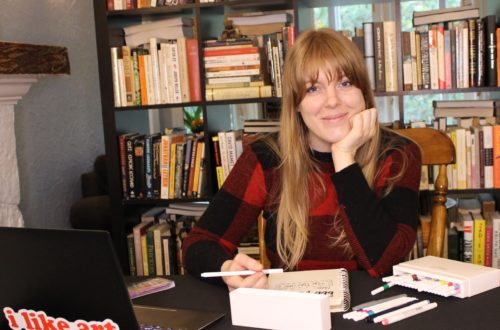- Developing Your Online Classroom: Zoom Classes
- Art Dog Ed: Wet Paint’s Virtual Classes
- Teach from Anywhere to Everywhere: Building a Virtual Classroom
We are all coming to terms with the importance of going virtual and using technology to creatively reach customers during pandemic times. For an introduction to conducting a class via Zoom, check out our recent feature with Scott Stevenson where he details his challenges and successes after hosting a class for Allard’s, and Cassie’s recent article on building a Portable Digital Classroom.
Once you check out that overview, come back here for the deep cuts! What is the draw of virtual classes for creatives stuck at home? And what does a successful model look like? Wet Paint in Saint Paul, MN, has been pleased with a positive response to their virtual classes, and Classes & Events Manager Virginia McBride shared some reflections as to why. Read on for tips from Wet Paint as well as a recap of my experience attending one of their classes firsthand.
Four Tips for a Strong Foundation
- Vendor partnerships ramp up customer interest. “Partnering with a vendor for a demo who also promotes the event can really broaden your audience,” Virginia says. “We offered a weekend discount on the featured products to attendees and worked with the vendor to get orders shipped quickly. I woke up one morning to over 150 registrations in my inbox. We saw big sales and have gained and retained many new customers from all over the country!”
- Increased accessibility expands your customer reach. “Just like that, we now have a classroom that is many times larger than we had in the store. We add ‘Central Time’ on all the class event listings and all our emails are now sent to our full email list, not just local,” Virginia points out. “Students who were previously a little too far away to drive to the store for a class are delighted and registering more than ever. Virtual classes will be really nice for our regional folks in winter, too.”
- Varied formats allow customers to find the right fit. Offering an assortment of class lengths (both in terms of the session and overall program) is a great way to reach more people. “Most of our classes are one to two hours of live online-time, and we offer a variety of formats, from single stand-alone sessions to two-day workshops to three weekly session classes to six weekly session classes.”
- Set instructors up for success! Virtual classes are an adjustment for everyone: don’t expect your instructors to figure it out on the fly. Making sure they have a positive experience will not only strengthen your programming; the good vibes will also be palpable for the eventual attendees. “I help instructors who have not taught online before get started by doing a dry run with them, first one-on-one and then for a practice class, live with a small group,” Virginia says. The trial run with a focus group is a great way to build relationships with your “gold circle” of customers. “We offered a free, by-invitation-only class to a group of regular Rosemaling students with Julie Anderson,” Virginia says. “It was a win-win! The instructor got to practice in a live setting and get valuable feedback from the students who know her well. It brought the group together after many months of no classes for a free, short lesson where they painted postcards together for Wet Paint’s Annual Summer Postcard Project. It generated ideas for future classes and was a fabulous way to keep connections to the store alive, helping each other in the process.”
Zoom Newbie: My First Virtual Art Class
I’m a self-taught watercolor enthusiast and have never taken an in-person class before, let alone a virtual one. I learned about the lineup of virtual art classes at Wet Paint through their newsletters, and the Two-Tube Watercolor Painting series caught my eye. A recurring series with an intriguing theme that felt both manageable and challenging? Just $16? And focusing on my all-time favorite medium? I signed up, cleared a surface in my room and put myself in a customer’s shoes.
The registration process included a list of materials, instructions for the day of and an email reminder that included the Zoom link. The morning of the class, I laid out my materials, set up my lighting and stepped into the virtual classroom. The Wet Paint team (Virginia as host and Jinjer Markley, the instructor) opened with about five minutes of tech support: 17 students (about 10 of whom had their cameras on) began with the standard “Hellos” and “Is this thing on?” that many of us are growing accustomed to during a time when virtual gatherings, video calls and Zoom meetings are integral to many of our daily lives. Once we resolved the audio and camera issues, Virginia welcomed the group, gave us an overview of the format of the class and introduced our instructor, Jinjer. Jinjer was ready to go with two camera views: an overhead view of her workspace and the standard here’s-my-face-while-I-talk-to-you view.
Overview: The Experience
This class was empowering because it showed me that from two colors I could make a rainbow, and could make my own choices about reordering my palette in a way that meets my needs, feels fun and invites creativity. Jinjer opened with a little show and tell of paintings she has made in the past with two colors. She then went on to discuss each material, from paint tube to palette to brush choice, and set us up with our palette.
The class was an opportunity to set ourselves up for success while painting on our own, later: she took time to explain color theory, demonstrate best practices for using a watercolor brush and maintaining the purity of our two-tube palette. People asked questions in the chat and verbally throughout the experience, and Virginia did a great job of pointing Jinjer to the chat.
Key Takeaway: Have a Host
I can’t stress enough the impact of having a co-host! “If we have a large enrollment, I stay on as the host to “manage the house” admitting latecomers and monitoring the chat function so the instructor can focus on teaching,” Virginia points out. See if you can designate a team member to co-host, hold space and answer technical questions, questions about hours/sales/promotions that might be relevant to the class; they also help the instructor remember any tips, announcements, or tech-related information so that they can focus on the lesson and shed some mental stress.
Why Virtual Art Classes Still Hit The Spot
Here’s what I loved about the class.
Those pearls of wisdom only an art teacher can properly deliver. I have really missed an art teacher presence in my life, where someone is talking about the literal limitations of, say, only using Lemon Yellow and Indigo, and we might connect it to a concept that applies to something as monumental as our life purpose and constrained reality under COVID. “Constraint inspires creativity,” Jinjer says. I had a feeling this resonated deeply with my newfound classmates, peeking out from our various craft spaces and makeshift studios.
The unique personality and narrative style of a particular teacher. During a lesson, an art teacher is not just a skilled artist, they are also a coach and narrator. Jinjer narrated her actions in a way that not only slowed down my thought process and allowed new information to soak in, it was also entertaining and soothing. A virtual art class is not a polished recording you play over and over again: it’s in real-time, but even slower. Jinjer narrated much of what she did, from double-washing her brushes to drying the brush so as not to dilute with any unnecessary water. I have painted my whole life, but it was refreshing and invigorating to feel like I was inside the mind of another artist!
The comfort and connection of a class environment. Zoom meetings, webinars and workshops are not always inviting places to ask “stupid” questions. We don’t want to feel like the vulnerable one in the room. But the familiarity of an art class translated, even over the interwebs. I was struck by a feeling I hadn’t been expecting: this experience was comforting. It was comforting to see other people in their studios. It was comforting even when the internet dipped out for a second, because people wait patiently and then we are right back in it. It’s imperfect, and that’s okay. It’s grassroots, not glossy. Authentic, soothing and interesting. Five stars.
By the way: intense knowledge of the product. In addition to art class feels, this class also highlighted just how much art educators who partner with art supply stores know about specific products! WOW! From the design of her palette and how it serves the project, to different tools for creating a layout, Jinjer went deep. Really specific tips came up: using a piece of paper in between hand and paper to protect the surface from any oils on your skin, how the same pigment may be different across different brands.
Accessibility: technology in some ways making the experience…better!? The level of accessibility here cannot be undersold. Yes, you need a sturdy internet connection. But aside from that, you can plug in and hear the instructor at your preferred volume. The instructor can actually zoom in (spotlight their video) so that everyone gets exactly the same detailed view. They can utilize apps like a Black & White app on their phone to work with value by sharing their screen. Becoming well-versed in virtual art classes is not only necessary to handle pandemic-protocols, it’s also an action that makes your classes more accessible to people with limited access to transportation, illness or disabilities that would prevent them from attending in person, or people who would otherwise need to book childcare to take some “me time” in the form of a watercolor class.
Strangely Intimate
Virginia had mentioned that these classes can be intimate, and I’m no longer surprised by that. “Students have commented on how much they enjoy talking to others about art and the artistic process with people from other communities…especially if they are at home alone or with someone who doesn’t share their interests,” Virginia shares. She makes an effort to create a sense of community that people typically get through an in-person class experience. “I added optional 10 minute sharing sessions prior to the start of class so students can show what they made from the previous session or ask questions. I also stay in touch with students through follow up group emails containing recorded videos and links to things that were mentioned in class, mentioning upcoming classes or sales as I do.”
Creating safe, virtual spaces to slow down, make art together and keep art materials relevant in people’s lives is an important way to engage with the community and ground your business despite the disruptive twists and turns of 2020.
Are you hosting virtual classes? Have you connected with customers in new, refreshing ways? Are you struggling with challenges? We want to hear your stories. Reach out at artdogblog (@) macphersonart.com.






